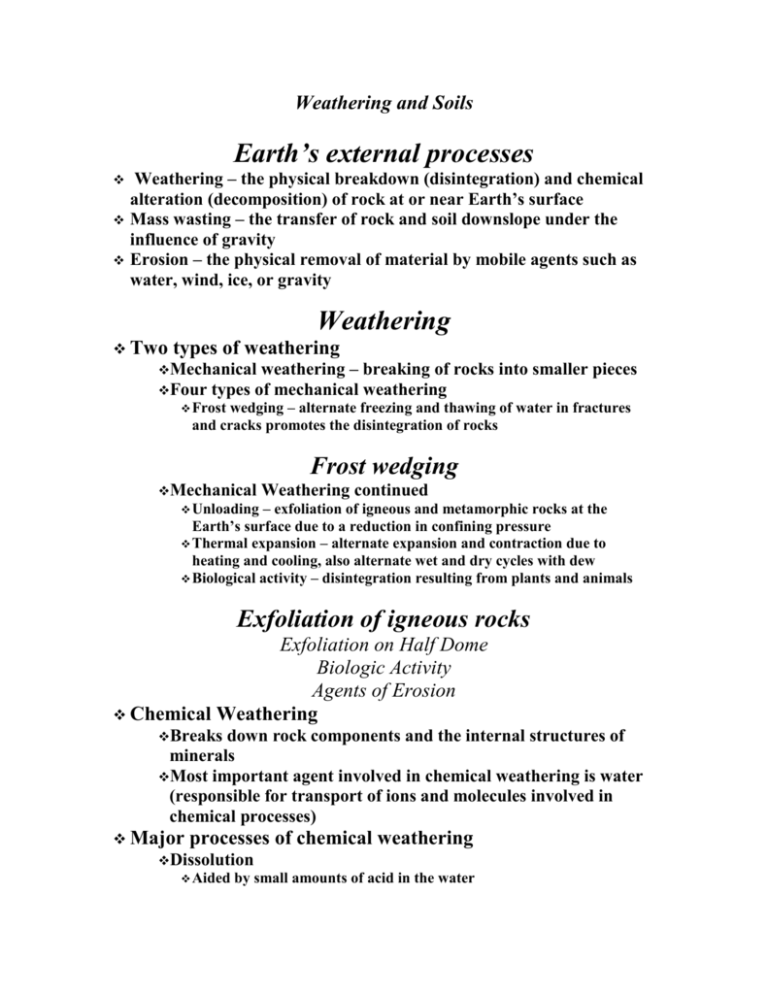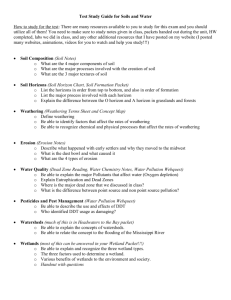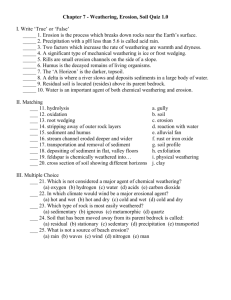Notes For Chapter 7 - Bakersfield College
advertisement

Weathering and Soils Earth’s external processes Weathering – the physical breakdown (disintegration) and chemical alteration (decomposition) of rock at or near Earth’s surface Mass wasting – the transfer of rock and soil downslope under the influence of gravity Erosion – the physical removal of material by mobile agents such as water, wind, ice, or gravity Weathering Two types of weathering weathering – breaking of rocks into smaller pieces Four types of mechanical weathering Mechanical wedging – alternate freezing and thawing of water in fractures and cracks promotes the disintegration of rocks Frost Frost wedging Mechanical Weathering continued – exfoliation of igneous and metamorphic rocks at the Earth’s surface due to a reduction in confining pressure Thermal expansion – alternate expansion and contraction due to heating and cooling, also alternate wet and dry cycles with dew Biological activity – disintegration resulting from plants and animals Unloading Exfoliation of igneous rocks Exfoliation on Half Dome Biologic Activity Agents of Erosion Chemical Weathering Breaks down rock components and the internal structures of minerals Most important agent involved in chemical weathering is water (responsible for transport of ions and molecules involved in chemical processes) Major processes of chemical weathering Dissolution Aided by small amounts of acid in the water Soluble ions are retained in the underground water supply Oxidation Any chemical reaction in which a compound or radical loses electrons in decomposing ferromagnesian minerals Important Major processes of chemical weathering Hydrolysis The reaction of any substance with water Hydrogen ion attacks and replaces other positive ions Oxidation and Hydrolysis Alterations caused by chemical weathering Decomposition of unstable minerals Generation or retention of materials that are stable Physical changes such as the rounding of corners or edges Joint-controlled weathering in igneous rocks Rates of weathering Advanced mechanical weathering aids chemical weathering by increasing the surface area Others factors affecting weathering Rock characteristics Rocks containing calcite (marble and limestone) readily dissolve in weakly acidic solutions Increase in surface area by mechanical weathering Others factors affecting weathering Rock characteristics continued Silicate minerals weather in the same order as their order of crystallization Climate Temperature Chemical and moisture are the most crucial factors weathering is most effective in areas of warm, moist climates Order of Weathering Same as order of Formation Differential weathering Masses of rock do not weather uniformly due to regional and local factors Results in many unusual and spectacular rock formations and landforms Differential Weathering Soil Soil is a combination of mineral and organic mater, water, and air That portion of the regolith (rock and mineral fragments produced by weathering) that supports the growth of plants Typical components in a soil that yield good plant growth Organic Material Factors controlling soil formation Parent material soil – parent material is the underlying bedrock Transported soil – forms in place on parent material that has been carried from elsewhere and deposited Residual Factors controlling soil formation Time Important in all geologic processes Amount of time for soil formation varies for different soils depending on geologic and climatic conditions Climate Most Key Factors influential control of soil formation factors are temperature and precipitation controlling soil formation Plants and animals Organisms Also influence the soil’s physical and chemical properties furnish organic matter to the soil Slope Steep slopes often have poorly developed soils terrain is a flat-to-undulating upland surface Optimum Variations in soil development due to topography Not Much Soil Development in Mountains The soil profile Soil forming processes operate from the surface downward Vertical differences are called horizons – zones or layers of soil The soil profile horizon – organic matter A horizon – organic and mineral matter O High biological activity Together the O and A horizons make up the topsoil E horizon – little organic matter Zone The of eluviation (fines) and leaching (solubles) soil profile horizon – zone of accumulation (can be hardpan) C horizon – partially altered parent material B The O, A, E, and B horizons together are called the solum, or “true soil” An idealized soil profile A soil profile showing different horizons Shallow Soil Profile A Less-Than Idealized Profile Soil types The characteristics of each soil type primarily depend on the prevailing climatic conditions Three very generic soil types Pedalfer Accumulation Three of iron oxides and Al-rich clays in the B horizon very generic soil types Pedalfer Best continued developed under forest vegetation Pedocal High accumulations of calcium carbonate with dry grasslands and brush vegetation Associated Three very generic soil types Laterite Hot and wet tropical climates chemical weathering Intense Bauxite Soil erosion Recycling of Earth materials Natural rates of soil erosion depend on Soil characteristics Climate Slope Type of vegetation In many regions the rate of soil erosion is significantly greater than the rate of soil formation Sedimentation and chemical pollution Related to excessive soil erosion Occasionally soil particles are contaminated with pesticides Aeolian Soil Erosion Mass Wasting: The Work of Gravity Mass Wasting and landform development Mass wasting refers to the downslope movement of rock, regolith, and soil under the direct influence of gravity Role of mass wasting Geologic process that often follows weathering Combined effects if mass wasting and running water produce stream valleys For mass wasting to occur, there must be a slope angle Most rapid events occur in areas of rugged, geologically young mountains As a landscape ages, less dramatic downslope movements occur Controls and triggers of mass wasting Gravity is the controlling force Important triggers include Saturation of the material with water Diminishes particle cohesion Water adds weight Oversteepening Stable Important of slopes slope angle (angle of repose) is different for various materials triggers include Oversteepening Oversteepened Removal of slopes slopes are unstable of anchoring vegetation Ground vibrations from earthquakes May cause expensive property damage Can cause liquefaction – water saturated surface materials behave as fluid-like masses that flow Landslides without triggers Slope materials weaken over time Random events that are unpredictable Classification of mass wasting events Generally Type each event is classified by of material involved Debris Mud Earth Rock Generally Type each event is classified by of motion Fall (free-falling pieces) Slide (material moves along a surface as a coherent mass) Flow (material moves as a chaotic mixture) The velocity of the movement Fast Slow Forms of mass wasting Slump Movement of a mass of rock or uncon-solidated material as a unit along a curved surface Occurs along oversteepened slopes A slump with an earthflow at the base La Conchita Slump Local Slumping Rockslide Blocks of bedrock slide down a slope Generally very fast and destructive Debris flow (mudflow) Consists of soil and regolith with a large amount of water Often confined to channels Slumps Due to Earthquake Rockslide Debris flow Serious hazard in dry areas with heavy rains Debris flows composed mostly of volcanic materials on the flanks of volcanoes are called lahars A lahar from the 1980 Mt. St. Helens eruption Earthflow Form on hillsides in humid regions Water saturates the soil Commonly involve materials rich in clay and silt An earthflow on a newly formed slope Slow movements Creep Gradual movement of soil and regolith downhill by the alternate expansion and contraction of the surface material Aided Creep Some visible effects of creep Evidence of Creep Slow movements Solifluction Promoted by a dense clay hardpan or impermeable bedrock layer Common in regions underlain by permafrost Can occur on gentle slopes Permafrost regions in the Northern Hemisphere Ground subsidence in Alaska due to permafrost Key Terms Chapter 7 Weathering Regolith Soil Mechanical and chemical weathering Joint Dissolution Clay Sand Humus Soil horizon (O, A, E, B, C), soil profile Erosion Bed load Suspended load Saltation Glacier Mass wasting Slope failure Flow Creep






